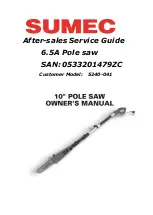
6
ENGLISH
Maintain a firm grip with both hands on the saw and
position your arms to resist kickback forces. Position
your body to either side of the blade, but not in line
with the blade.
Kickback could cause the saw to jump
backwards, but kickback forces can be controlled by the
operator, if proper precautions are taken.
When blade is binding, or when interrupting a cut for
any reason, release the trigger and hold the saw
motionless in the material until the blade comes to a
complete stop. Never attempt to remove the saw from
the work or pull the saw backward while the blade is
in motion or kickback may occur.
Investigate and take
corrective actions to eliminate the cause of blade binding.
When restarting a saw in the workpiece, centre the
saw blade in the kerf and check that saw teeth are not
engaged into the material.
If saw blade is binding, it may
walk up or kickback from the workpiece as the saw is
restarted.
Support large panels to minimise the risk of blade
pinching and kickback.
Large panels tend to sag under
their own weight. Supports must be placed under the
panel on both sides, near the line of cut and near the edge
of the panel.
Do not use dull or damaged blades.
Unsharpened or
improperly set blades produce narrow kerf causing
excessive friction, blade binding and kickback.
Blade depth and bevel adjusting locking levers must
be tight and secure before making cut.
If blade adjustment
shifts while cutting, it may cause binding and kickback.
Use extra caution when making a "plunge cut" into
existing walls or other blind areas.
The protruding blade
may cut objects that can cause kickback.
Safety instructions for saws with a pendulum blade guard
Check lower guard for proper closing before each use.
Do not operate the saw if lower guard does not move
freely and close instantly. Never clamp or tie the lower
guard into the open position.
If saw is accidentally
dropped, lower guard may be bent. Raise the lower guard
with the retracting handle and make sure it moves freely
and does not touch the blade or any other part, in all
angles and depths of cut.
Check the operation of the lower guard spring. If the
guard and the spring are not operating properly, they
must be serviced before use.
Lower guard may operate
sluggishly due to damaged parts, gummy deposits, or a
build-up of debris.
Lower guard should be retracted manually only for
special cuts such as "plunge cuts" and "compound
cuts." Raise lower guard by retracting handle and as
soon as blade enters the material, the lower guard
must be released.
For all other sawing, the lower guard
should operate automatically.
Always observe that the lower guard is covering the
blade before placing saw down on bench or floor.
An unprotected, coasting blade will cause the saw to walk
backwards, cutting whatever is in its path. Be aware of the
time it takes for the blade to stop after switch is released.
Additional safety instructions for all saws with riving knife
Use the appropriate riving knife for the blade being used.
For the riving knife to work, it must be thicker than the
body of the blade but thinner than the tooth set of the
blade.
Adjust the riving knife as described in this instruction
manual. Incorrect spacing, positioning and alignment can
make the riving knife ineffective in preventing kickback.
Always use the riving knife except when plunge cutting.
Riving knife must be replaced after plunge cutting. Riving
knife causes interference during plunge cutting and can
create kickback.
For the riving knife to work, it must be engaged in the
workpiece. The riving knife is ineffective in preventing
kickback during short cuts.
Do not operate the saw if riving knife is bent. Even a light
interference can slow the closing rate of a guard.
Additional safety instructions for circular saws
Warning!
Never operate the tool in an inverted position. Do
not clamp the tool in a vice or fasten it to a supporting surface.
Wear ear protectors.
Exposure to noise can cause
hearing loss.
Be aware of hidden hazards.
Before cutting into walls,
floors or ceilings, check for the location of wiring and pipes.
Make sure the blade is securely fixed and rotates in
the correct direction.
Always use blades of the correct
size as specified in these operating instructions.
Do not use blades of larger or smaller diameter than
recommended
. For the proper blade rating refer to the
technical data. Use only the blades specified in this
manual, complying with EN 847-1.
Never use blades made from high speed steel (HSS).
Never use abrasive grinding or cutting discs with this tool.
The blade will continue to move after releasing the
switch.
Always switch the tool off and wait for the saw
blade to come to a complete standstill before putting the
tool down.
This appliance is not intended for use by young or
infirm persons without supervision.
Children must be
supervised to ensure they do not play with the appliance.
Warning!
Contact with or inhalation of dusts arising from
cutting applications may endanger the health of the operator
and possible bystanders. Wear a dust mask specifically
designed for protection against dust and fumes and ensure
that persons within or entering the work area are also
protected.
Summary of Contents for Powerful Solutions KS1400L
Page 2: ...2 A 14 13 15 16 9 B C D 17 11 19 20 18 23 22 21 ...
Page 3: ...3 E F G H 24 25 8 26 21 28 27 29 30 6 ...
Page 96: ...96 ...
Page 97: ...97 ...







































